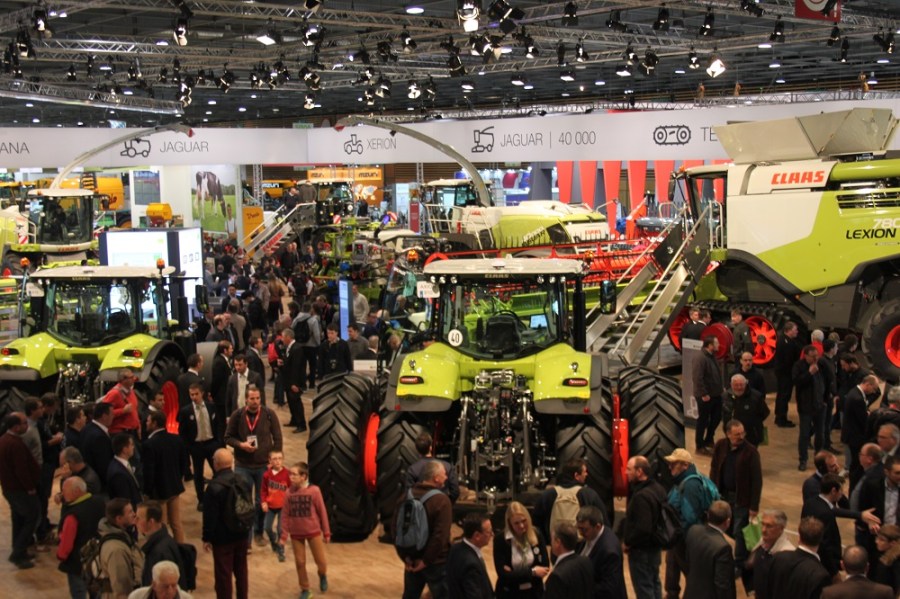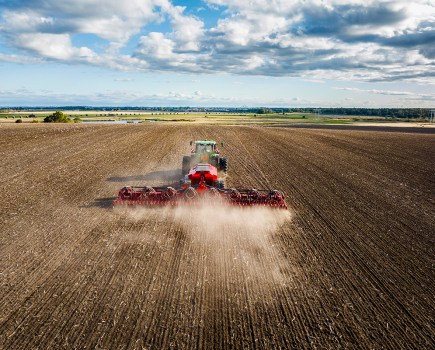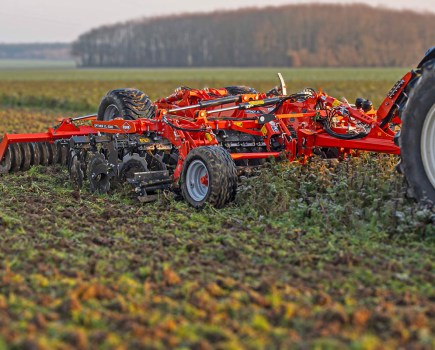Paris was the place to be in late Feb for the latest in developments from the major farm machinery manufacturers, and CPM was at SIMA to pick out some of the highlights from the new products on show.
By Martin Rickatson
The last SIMA show in 2017 came during a period of tough times for French arable agriculture. Off the back of difficult weather during critical points in the previous year, there were resulting poor crop performances and a knock-on depression in the machinery market. The 2019 event back in Feb provided a marked contrast, however.
Among the 230,000 visitors, a quarter of whom came from 140 countries other than France, there was a notably more buoyant mood, and it appeared to be mirrored by the levels of both innovation and optimism among the 1800 exhibitors. Beyond the usual updates of existing equipment, there was plenty of new thinking among the products launched at the event.

The latest addition to Amazone’s Cirrus cultivator drill range is the 4/6m CC variant, which has a 4000-litre 60/40 split hopper.
Tractors and tyres
Most of the major tractor manufacturers appear to currently be on a hiatus in terms of major moves in model development, with the cost and complexity of meeting Stage V emissions regulations perhaps having soaked up a good deal of R&D funding. However, the march down the power scale of CVT transmissions continues, with their trade-off of additional cost against fuel efficiency benefits and ease of operation.
Pitched as an alternative to the similarly-powered powershift-equipped Luxxum, Case IH’s new four-model 100-130hp Versum CVXDrive range slots in below the larger, more heavily-built four-cylinder 116-145hp Maxxum line, previously the smallest models available with CVT. Powered by 4.5-litre four-cylinder Stage V FPT Industrial engines, the tractors’ electronically-controlled CVXDrive transmission provides stepless travel up to 40km/h. An Active Hold Control feature means stopping on hills and at road junctions is possible without using the footbrakes. Up to seven mechanically or electronically controlled hydraulic remote valves are available, plus a power beyond function, supplied by a 110 l/min closed-centre load-sensing hydraulic system.
For those who prefer the length and weight distribution of a six-cylinder tractor design to a four-cyl in the 100-150hp bracket, New Holland chose SIMA to add a second six-cylinder offering to its 116-145hp (rated) T6 tractor line, which otherwise consists of four-cyl models. The new 135hp (rated)/165hp (max) T6.160 model is an alternative to the four-pot T6.165, which has the same power figures. However, it delivers up to 12% higher torque than the four-cylinder model, with a maximum figure 740Nm compared to the 700Nm of the four-cyl model, while engine braking is said to be 50% higher.
Displayed on the John Deere stand was hitch specialist Laforge’s Dynatrac universal guidance interface, awarded gold in the SIMA innovation awards scheme. Coupled between rear linkage and implement, and controlled by GPS or camera guidance, it allows lateral movement of the implement in relation to the tractor to ensure implement positioning accuracy to within 2.5cm, decoupling the implement’s motion from the tractor’s movement. Laforge says this enhances tracking of the tractor’s trajectory.
Beyond tractors themselves, a number of tyre companies also used SIMA as a launchpad for new products. BKT showed off its largest tractor tyre to date – the 750/75 R46 version of its Agrimax Force IF increased flexion type has a diameter of 2.30m. Meanwhile, fellow Indian manufacturer CEAT announced the expansion of its agriculture tyre range to add high-power tractor tyres, harvester tyres and steel belted flotation tyres, joining its recently-launched Farmax mid-power radials, Floatmax flotation tyres and Farmax RC row crops. Manufactured at CEAT’s two year-old farm radial-dedicated factory in Ambarnath, India, the CEAT products are distributed in the UK by Nordic Tyres and GB Tyres.
Claas’ new Satcor satellite-aided correction signal works with American GPS, Russian GLONASS and Galileo European satellite networks for maximum reliability, says the firm. A Claas steering system with S10 terminal supplied from April 2017 or S7 supplied from Oct 2018 onwards is all that’s needed to receive the signal, which has a repeatable accuracy level greater than 15cm, making it a reliable alternative to correction signals that are freely available but sometimes usable only to a limited extent, suggests Claas.
Also new, its EASY on-board app allows machines to be controlled by an in-cab iPad via ISOBUS, connected via the Claas wireless interface. A connection kit for ISOBUS wiring is available for older tractors. An extended range of functions is available when the EASY on-board app is linked to the Claas 365FarmNet portal, with data exchanged directly via the internet. Jobs can be created in 365FarmNet, then accessed and processed in the app, or vice versa.
Advances in handling
In the UK, Claas is continuing to focus the wheel loader fruits of its co-operation with Liebherr on the 7750-12,400kg capacity 1177-1914 models. But at SIMA it announced three new Torion machines with lift capabilities of 3750-5575kg. They combine articulation and rear-axle steering to fulfil the needs of those seeking maximum manoeuvrability. As part of the steering movement, the hydraulic ram in the articulated joint also automatically moves the rear axle.
Primarily targeted at livestock farms, Manitou nevertheless expects its wheel loader range, now comprising eight models with capacities of up to 5.0t and lift heights of up to 5.20m, to also appeal to certain arable users. The largest MLA-T 516-75 H and MLA-T 533-145 V+ models (5.20m lifting height, 3.3t maximum capacity) have 75/145hp engines and hydrostatic/M-Vario Plus CVT transmissions.
Also on show was the MLT 961-145 V+ L, a new 6t/9m machine aimed at large grain stores and straw operations. Manitou also showed its High View feature option for the MLT NewAg telehandlers – a camera fitted to the boom head which automatically sends images to a screen in the cab – plus the EcoStop development. When activated, the latter automatically shuts off the engine after a specified period of idling, configurable from one to 30 minutes. A 15% idling reduction on a machine used for 1000 hours per year could save almost £1300/year, calculates the firm.
Crop establishment
Among the tools for ground preparation, both New Holland and CNHi stablemate Kongskilde, some of whose machines the former is beginning to market, showed plough developments. New Holland’s new side-mounted CombiWheel, available for its heavy-duty PX/PXV/PXVOL ploughs, works inside the plough frame to allow ploughing to the edge of the headland. Kongskilde offers a similar design.
Among the highlights from Kuhn was the Aurock drill, its entrant into the ‘universal’ category for machines required to work in situations from no-till through min-till to fully-cultivated soil. With a 6m working width and 5000-litre seed hopper, it’s available with either single or, with a split hopper, dual metering, enabling establishment of two different crop types at different sowing depths. Drills configured this way feature two metering units and two distribution heads, and can be specified with a third hopper for microgranules or similar products.
A leading cover crop processing roller is an option, but the first element of the drill proper is a set of straight discs for slot-opening or wavy-edged types for mixing in cultivated ground. A full-width tyre packer roller firms the ground, with offset wheels to prevent soil build-up and minimise the power required to pull the drill. Two rows of parallelogram-mounted double-disc coulters place the seed.
New from Pottinger are 8m and 10m versions of its Terradisc compact disc cultivator. Capable of working at depths from 5-15cm, the firm reckons working speeds of up to 18km/h achieve the best results with the 8001T and 10001T. Two solid forged carrier arms are welded to a wide clamping bracket, a design the company reckons ensures the discs always retain their position and angle, even in heavy land. A central, hydraulically-adjusted working depth setting with jockey wheels is optional on the smaller model and standard on the larger. Rear roller options include cage roller, pack ring roller, rubber packer roller and Pottinger’s tandem Conoroll.
Drill innovations included the latest Solitair 23 front tank from Lemken, a 1900-litre hopper that can be paired with a rear-mounted coulter bar, or even the firm’s Azurit precision seeder. Available in pressurised and unpressurised versions, it can be mounted above a set of press wheels. Four metering units govern the supply of seed or fertiliser, while optional hopper weigh cells provide information on tank level and application rates.
Väderstad drill news at SIMA focused on the extension and enhancement of its precision planter line, with a new introduction eight-row model for its Tempo L range. The Tempo L 8 offers 700-800mm row spacing, but can also be configured as a 12-row machine planting at narrower 450-508mm spacings. Like other Tempo machines it features pressurised Powershoot seed metering and Fenix III fertiliser metering, plus hydraulically-telescopic axle. Like its larger 12- and 18-row stablemates, it offers 3000 litres of fertiliser capacity. Meanwhile, there are also new fertiliser hopper and narrow row spacing alternatives for Tempo L 12 and Tempo L 18 12- and 18-row machines, which can now be had with 450-508mm row spacing and 3000-litre fertiliser hopper options.
The latest addition to Amazone’s Cirrus cultivator drill range is the 4/6m CC variant, which has a 4000-litre 60/40 split hopper, and incorporates an intermediate row of deeper-working single disc coulters between the cultivation discs and the packer. This allows the drill to be set up for different scenarios depending on where the operator chooses to place seed and fertiliser, and if it’s desired to plant a second seed type, perhaps for a companion crop, alongside the main one. There’s also the option to add a further element using Amazone’s Green Drill seeder at the rear.
A three-way split hopper is also a feature of the latest SD models to join Horsch’s Avatar single-disc direct drill range. Equipped with two distribution heads, they can place three different products concurrently, fed via a tank that’s divided in a ratio of 30:10:60. Hopper capacity is 3900 litres on the 3m and 4m models and 5000 litres on the 6m and 8m versions.
French maker Sulky previewed two new drill ranges set to replace its established Xeos line next spring. For those with relatively simple requirements, the 3.0m Master is fitted with either Suffolk or single-disc coulters, the latter applying a force of up to 30kg. Seed capacity is 1250 litres.
For those seeking more versatility, the 3.0/3.5/4.0m ISOBUS-controllable Progress is available with single-disc, double-disc and Suffolk coulters. There’s three-product sowing capability, with all piped down the same hoses, which can be equipped with blockage sensors. An electronically-controlled distribution head allows easy tramline spacing adaptation and is compatible with variable-rate seeding.
Crop protection
Part of a suite of new precision technologies to be marketed by CNH Industrial’s agricultural businesses, Case IH won a bronze Innovation Award for XPower, a ‘digital herbicide’ technology developed by Swiss firm Zasso Group.
Designed for situations requiring non-selective weed control, the 1.2-3.0m XPower units apply high voltage electric current on contact with the weed leaves. Another element touching another weed closes the electrical circuit and the weed chlorophyll is damaged immediately. Units can be adapted for different row crop systems, and can be controlled via ISOBUS Class 3 compatible tractors.
Kubota continues to expand its arable equipment line for large farms with the launch of new XTS trailed sprayers at SIMA, sourced from its Kverneland business. The 2600- and 3200-litre nominal capacity models come with 18-30m steel or 21-24m aluminium booms. Available features include those already established on Vicon/Kverneland-branded machines, such as IsoMatch Tellus Pro terminal screen or IsoMatch Grip joystick control via ISOBUS using IsoMatch GeoControl, plus fully-automatic iXclean Pro liquid management.
Berthoud’s Spraytronic pulse technology was making its SIMA debut, following its late 2018 launch as an option for Vantage trailed and Raptor self-propelled models. Based on forward speed, a solenoid valve on each sprayer nozzle momentarily interrupts flow multiple times per second, with the ratio between the opening and closure time changing according to the speed variation at a fixed frequency, varying it by up to 70% without changing the operating pressure, and using a single nozzle type. Preview material on the stand illustrated work the firm is doing to extend Spraytronic’s use into spot-spraying, in combination with camera-based weed recognition.




